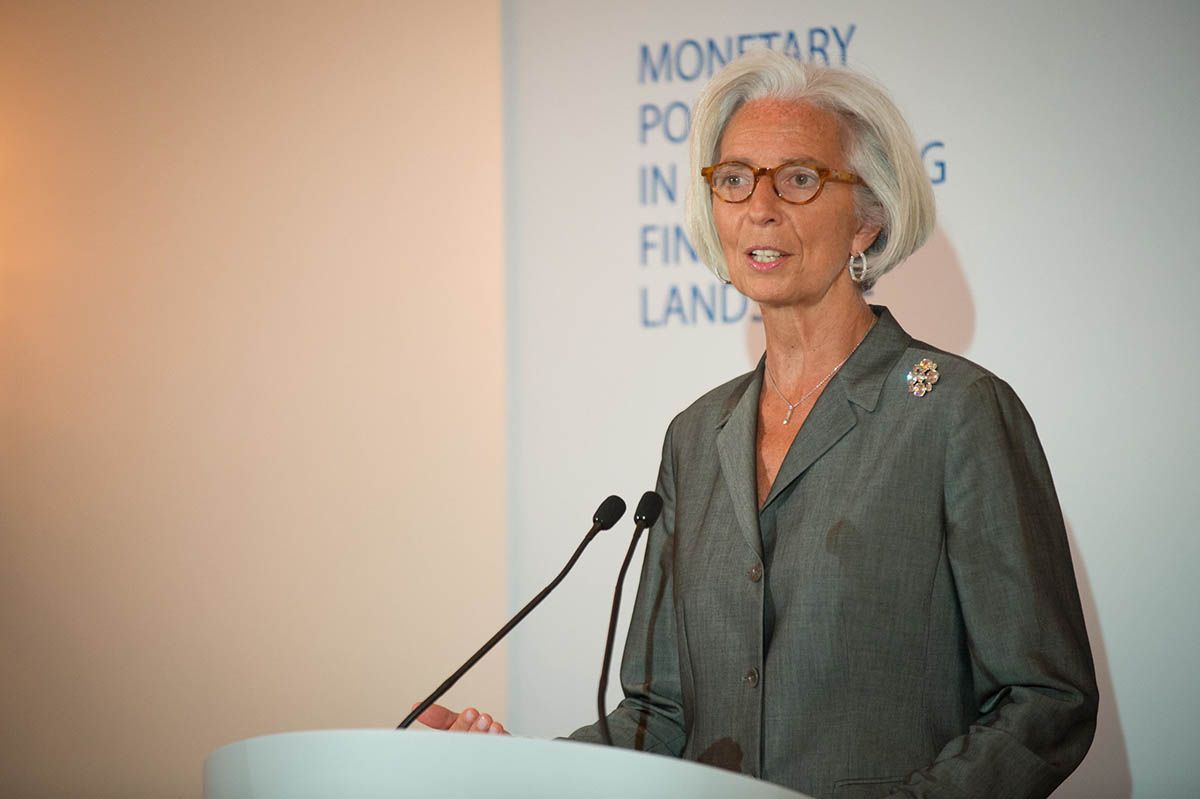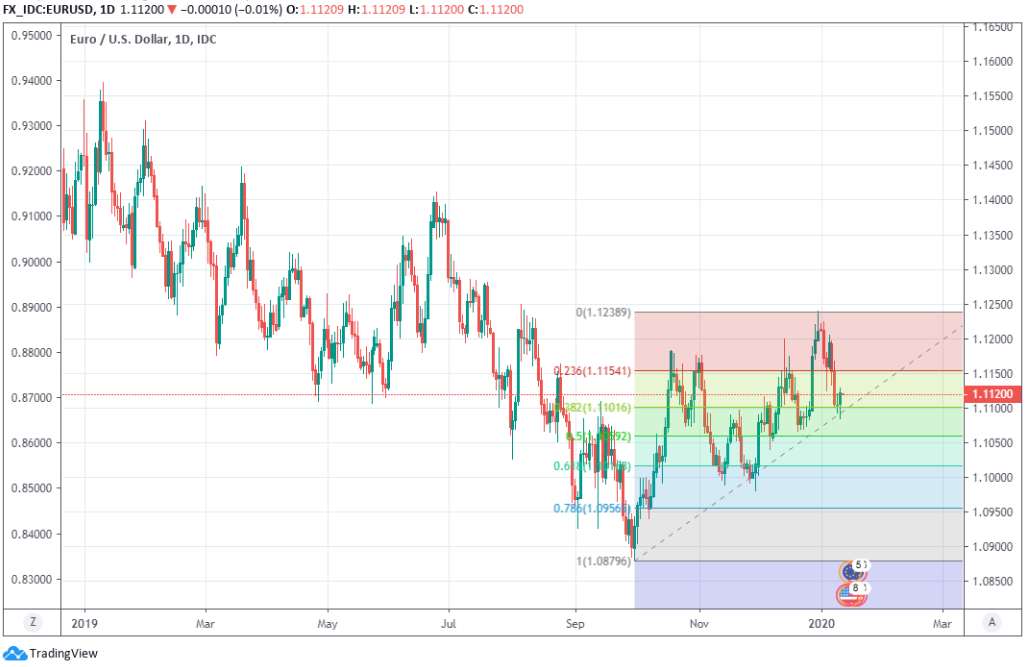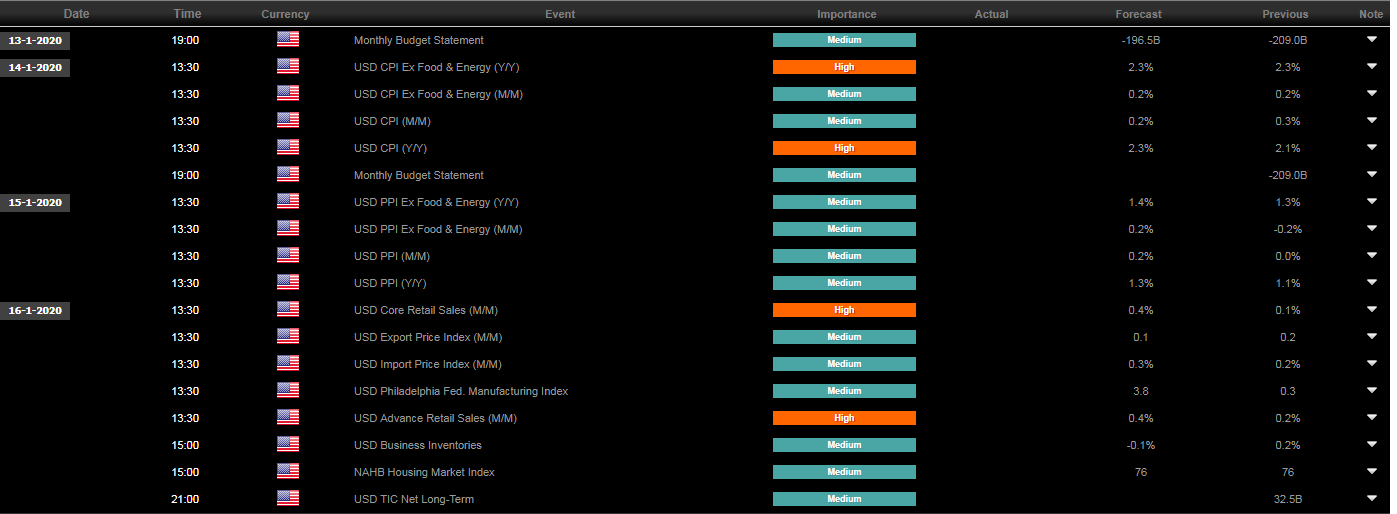Euro-to-Dollar Week Ahead Forecast: Nearing Support on Charts as Global Factors Set the Agenda
- Written by: James Skinner
- EUR/USD sees stabilisation, 1.1052 and 1.1197 both key levels.
- After weak finish for USD on soft year-end jobs and wages data.
- EUR takes cues from ECB minutes, Lagarde and global factors.
- U.S. CPI, retail sales, Chinese GDP, trade deal are key this week.

Above: File image of ECB President Christine Lagarde © European Central Bank, reproduced under CC licensing
- EUR/USD spot rate: 1.1128, up 0.07% today
- Indicative bank rates for transfers: 1.0739-1.0817
- Transfer specialist indicative rates: 1.0950-1.1030 >> get your quote now
The Euro starts the new week on a positive footing as it looks to put a floor under the losses it experienced against the U.S. Dollar over the course of the previous week, and further near-term support could be found a technical support level on the chart that is now close at hand.
From a fundamental perspective, the most important influences on EUR/USD in the week ahead will be a series of U.S. economic figures as well as a steady drip feed of geopolitical developments.
"All conditions seem united for allowing the greenback to appreciate further short-term. Easing Middle East tensions combined with both the state visit of Chinese Vice Premier Liu He to sign the interim trade deal in Washington due next week along with upbeat labor data releases on Friday should put the greenback on track to post its strongest weekly gain in two months after a two-week session loss," says Vincent Mivelaz, an analyst with Swissquote Bank.
Looking at the technical setup in EUR/USD, "there is scope for a deeper sell off to the 100 day ma at 1.1065, but we should see some stabilisation between here and the 3 month uptrend at 1.1052," says Karen Jones, head of technical analysis at Commerzbank. "Overhead the market is facing tough resistance at 1.1197-1.1240 – namely the 55 week ma, the 2019-2020 down channel and the recent high. This guards the 200 week ma at 1.1360 which continues to represent a critical break point medium term."
Above: Euro-to-Dollar rate at 4-hour intervals with Fibonacci retracements of the post-September uptrend marked out.
Jones says the Euro should challenge the 1.1215 level over the coming weeks and that if this threshold is overcome, the single currency will then have a clear rund at the 200-week moving-average of prices located around 1.1360. But she's also warned that a slide below 1.1052 would incite a further leg down that could ultimately see the Euro testing its November 29th low at 1.0981.
Commerzbank's technical analysts are betting on a rebound over the coming months after having bought the single currency around 1.1140 and again at 1.1168. They're targeting a move up to 1.1350 but have a 'stop-loss' set at 1.1090, which means they'll walk away from the wager if that level crystalises.
The Euro has turned a corner since August 2019 which is when markets had fully priced-in the anticipated September stimulus from the European Central Bank (ECB) and was when the prospect of a 'no deal' Brexit began fading in earnest and the probability of an orderly UK EU-exit rose.
It was also around the time that President Donald Trump began to step back from what had marked the most significant escalation of the trade war with China to date. The two parties are expected to sign what is effectively a ceasefire agreement on Wednesday this week.
Above: Euro-to-Dollar rate at daily intervals with Fibonacci retracements of the post-September uptrend marked out.
AA
The Euro: What to Watch
The Euro struggled struggled last week and was down against both the Pound and Dollar by the closing bell on Friday even after a series of positive economic surprises, with the single currency having proven more sensitive to international developments and susceptible to the overtures of the greenback.
Europe's single currency drew no inspiration from IHS Markit PMI figures hinting at a tentative rebound the continental manufacturing sector for December last week, nor from Destatis reports of a strong rebound in German industrial production for November. Neither any of those nor any of the other positive releases were enough to prevent the continent's unified unit from ceding ground to the Dollar and Pound so it's not clear whether this week's limited number of outputs will have much impact either.
Wednesday at 10:00 am will mark the release of November industrial production figures for the Eurozone and markets are looking for output to have risen 0.3%, partially reversing a -0.5% decline from October. However, risk may be to the upside given that German figures surprised higher for the same month last week. Minutes of the December ECB meeting will be released Thursday at 12:45 and Christine Lagarde will speak later that day at 18:00.
Lagarde is due to speak at a New Year reception in Frankfurt and with the ECB saying in December it would conduct a 'strategic review' of its ongoing policy response to challenges faced by the Eurozone, markets will look this week for clarity on what that could involve and what it might mean for the Euro.
Above: Eurozone economic data due through this week along with results anticipated by market. Source: Netdania Markets.
"Risk sentiment should start the week on the front foot and be mildly supportive for the dollar against the low yielders such as the EUR. The highlight of the week, in theory, should be the signing of the phase-one of the trade deal in Washington on Wednesday," says Chris Turner, head of FX strategy at ING. "EUR/USD has started the year in a quiet fashion despite events in the Middle East and at the margin is showing a negative correlation with risk – as the EUR builds out its status as a funding currency."
The Euro is often said to be viewed as a 'funding currency' because of the ECB's negative interest rate policy, which means it's super cheap to borrow. It's cheapness sees the Euro borrowed and then sold, enabling investors to park the proceeds in higher yielding assets often in the emerging markets. Such speculation can be enough to keep the Euro under modest pressure when risk appetites are robust and lift it during times of risk-aversion as investors sell out of places like emerging markets.
Europe's single currency has been in decline against the Dollar and Pound since at least the early days of the first quarter 2018 but the year ahead brings with it a new set of circumstances that might enable it to get the better of the greenback at least. Notably, the November election and preceding campaigns could place a question mark over the Trumpian economic and foreign policies that have lifted the Dollar so much over the last couple of years.
"As a result of US-Europe growth convergence, US-Europe relative monetary policy, a calmer geopolitical environment and favourable EUR FX valuations we expect EUR/USD to trade at current levels and approach 1.16 by end-2020, with risks to the upside if the US Presidential election leads to a USD negative surprise," says Jordan Rochester, a strategist at Nomura. "EUR remains the market’s largest short with leveraged accounts the largest holders. The US data are mixed and are slowing towards trend later this year, the US presidential election also provides a potential USD risk too."
AA
The U.S. Dollar: What to Watch
The Dollar was humbled Friday and quoted lower against all but two of its major rivals come the closing bell, although it was still top of the major currency class for the week overall and has a good shot at remaining in pole position over the coming days due to events in the global economic and political calendar.
Investors appeared to be willing to buy Dollar whatever the weather last week and may remain in a similar mood over the coming days, with the greenback benefiting from an increase in tensions between the U.S. and Iran as welll as a quick de-escalation. It wasn't until the December non-farm payrolls report left investors with a sour taste in the mouth on Friday that the greenback eventually ceded ground the rest of the major currency basket in unison.
The Dollar still acts as a safe-haven so can benefit from geopolitical tensions while the 1.75% cash rate of the Federal Reserve (Fed) is still the joint-highest in the developed world so the U.S. currency also tends to benefit from yield-seeking among investors during times when risk appetites are robust, mostly at the expense of lower yielding rivals like the Euro, Pound and non-Dollar safe-havens like the Yen and Swiss Franc.
"The Phase one signing ceremony will likely be the highlight of next week (Wednesday). It would be a massive shocker if the deal is not signed next week as even the Chinese side sounds positive. The new Chinese Fin-Twit Darling, Hu Xijin, has essentially promised the world that the deal will be signed and even went as far as praising Trump’s Iran press conference. The actual substance of the Phase one deal is highly debatable," says Andreas Steno Larsen, a strategist at Nordea Markets.
The first risk event for the Dollar and all other currencies this week is the release of U.S. inflation data for December at 13:30 on Tuesday when markets will be looking for the consumer price index to have risen 0.2% at year-end, in line with the move from the previous month. However, that's expected to lift the annualised rate of inflation from 2.1% to 2.3%. Meanwhile, the more important core inflation rate is seen remaining unchanged at 2.3%.
Above: U.S. economic data due through this week along with results anticipated by market. Source: Netdania Markets.
Official measures of inflation will then be above the 2% target, which in ordinary times might be enough to get the market talking about rate hikes from the Fed. But given the global backdrop and pressure from President Donald Trump rate hikes are expected to remain off the agenda through 2020. As a result, it's not clear what impact Tuesday's numbers will have on the greenback.
"Its hard not to be skeptical about the upcoming signing ceremony for the China-US Phase I trade deal given what we haven’t been told: its contents. Set to be concluded next Wednesday (or “shortly thereafter” according to President Trump’s latest comments), it’s highly unusual that this close to that date, the text of the deal has yet to be released. A translation into Chinese doesn’t take this long," says Avery Shenfeld, chief economist at CIBC Capital Markets.
U.S. retail sales figures for the month of December will be released at 13:30 on Thursday, proving investors with an early steer on the likely strength of consumer spending and the broader economy ahead of year-end. Consensus favours strong 0.4% increases for both headline as well as core retail sales. And then Chinese final quarter GDP data will be released in the early hours of Friday morning, with markets looking for the economy to have grown at an unchanged annualised pace of 6% into year-end.
Both of those latter releases will telling of the broader global economic performance around year-end but for the Dollar at least, the main event in the week ahead could be the anticipated signing on Wednesday of the much-vaunted but ever-elusive 'phase one deal' between the U.S. and China. Markets have still not seen the text of the agreement so are nonethewiser as to whether it does what President Donald Trump set out to do. And the answer to that question is key to the outlook for trade tensions.
"All of this should be a reminder that the sigh of relief we heard in financial markets on news of this deal looks premature, particularly since after the 2020 election, we might be heating up the trade war on the European theatre of operations. The flash points there include autos, US concerns over subsidies to Airbus, a French tax on the earnings of large US-based digital companies, and coming in 2020, a draft EU climate law that could include taxes on carbon-intensive imports from countries that are more lax on climate change action," says CIBC's Shenfeld. "Which country could that be?"
Time to move your money? The Global Reach Best Exchange Rate Guarantee offers you competitive rates and maximises your currency transfer. Global Reach can offer great rates, tailored transfers, and market insight to help you choose the best times for you to trade. Speaking to a currency specialist helps you to capitalise on positive market shifts and make the most of your money. Find out more here.
* Advertisement









